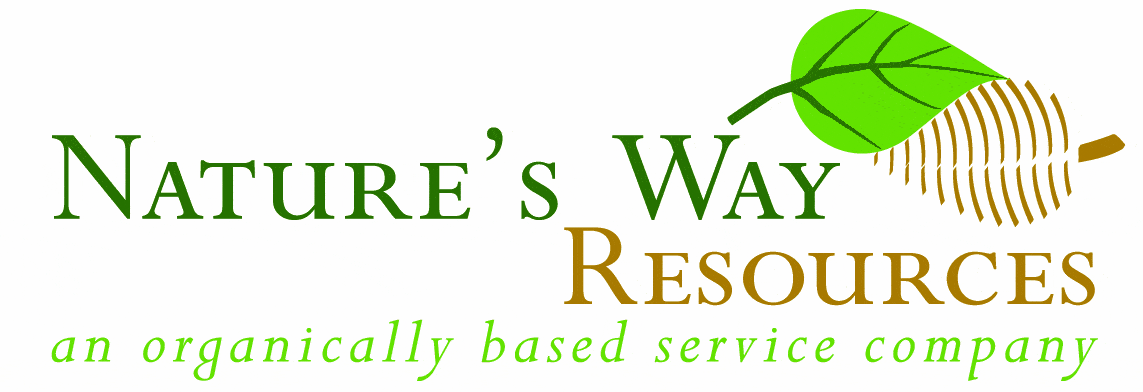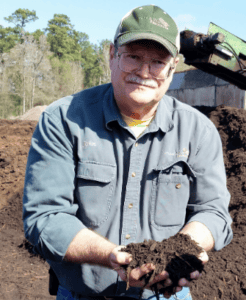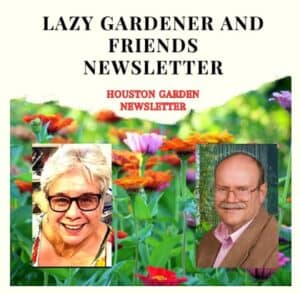 Nature’s Way Resources is proud to produce & email you this free weekly newsletter. We have no ads, but sponsors do graciously help support this project as a public service. Please note their names below & show your gratitude for this free service by patronizing their businesses! To become a sponsor, call (936) 273-1200
Nature’s Way Resources is proud to produce & email you this free weekly newsletter. We have no ads, but sponsors do graciously help support this project as a public service. Please note their names below & show your gratitude for this free service by patronizing their businesses! To become a sponsor, call (936) 273-1200
Nature’s Way Resources owner John Ferguson, “The Lazy Gardener” Brenda Beust Smith and Pablo Hernandez welcome your feedback and are so grateful to the many horticulturists who contribute their expertise
Click here to join our email list
CLICK HERE for PDFs OF PAST LG&F NEWSLETTERS
‘While it is February one can taste the full joys of anticipation.
Spring stands at the gate with her finger on the latch.’
— Patience Strong (1907-1990) English poet

Texas wild azaleas, left, and ‘Miss Joaquim’ orchids (LAURIE SKOV orchid photo)
‘In the Spring, I have counted 136 different kinds of weather inside of 24 hours’
— MARK TWAIN (aka Samuel Langhorne Clemens)
1835-1910 “Greatest humorist the United States has produced”
 “Rose-watching is the current fascination around here. Once a week everyone buys a single, long- stemmed rose IN bud and watches it unfurl day by day. It’s a simple, private way of calming nerves….”
“Rose-watching is the current fascination around here. Once a week everyone buys a single, long- stemmed rose IN bud and watches it unfurl day by day. It’s a simple, private way of calming nerves….”
— from “The Cat Who Went Bananas”
by Lillian Jackson Braun (2005
BY BRENDA BEUST SMITH
EVER TRIED ROSE-WATCHING?
I suspect the late author Lillian Jackson Braun invented this quote above for her “The Cat Who…” series. But it works! When rose buds appear, I try to remember to cut a tight bud, positioned it eye-level behind my laptop cover and stared at it every time I sit down to work. Seeing up close how petals so slowly unfurl IS relaxing and make me smile every time. Mission accomplished!
(First published here Dec.2 -’22, but worth repeating!)
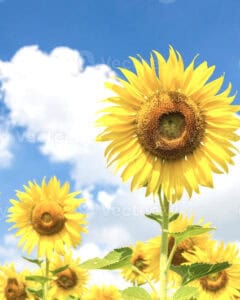 A REMINDER NOW WE’RE IN PLANTING MODE . . . Unlike Gardeners of ‘ol — we don’t learn from birth plant know-hows/tricks they took for granted. Eg: sometimes one reason a particular plant’s not doing well in an otherwise thriving garden is because all is not copacetic with its neighbors. Might be a case of allelopathy. Not your fault. Maybe some plants don’t want it nearby, so they kill it!
A REMINDER NOW WE’RE IN PLANTING MODE . . . Unlike Gardeners of ‘ol — we don’t learn from birth plant know-hows/tricks they took for granted. Eg: sometimes one reason a particular plant’s not doing well in an otherwise thriving garden is because all is not copacetic with its neighbors. Might be a case of allelopathy. Not your fault. Maybe some plants don’t want it nearby, so they kill it!
Plants with this ability release compounds lethal only to the unwanted plant. This isn’t all bad. Sunflower (Helianthus annuus) will release to eliminate nearby weeds, which can be helpful. Depends on what it — and you — consider a weed! Rest of story: Texas A&M AgriLife Organic.
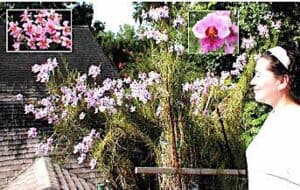 Believe it or not, this really is an orchid “vine”with SHELIA SKOV on a high ladder overlooking roofs underneath!’Miss Joaquim’orchid is a Vanda variety that grows in summer heat/sun but should be moved inside in our winters. She will be available at the upcoming Houston Orchid Society Show and Sale!(Laurie Skov photo)
Believe it or not, this really is an orchid “vine”with SHELIA SKOV on a high ladder overlooking roofs underneath!’Miss Joaquim’orchid is a Vanda variety that grows in summer heat/sun but should be moved inside in our winters. She will be available at the upcoming Houston Orchid Society Show and Sale!(Laurie Skov photo)
ORCHID GROWERS LAURIE & SHELIA SKOV point out there are over 20,000 different orchid species, with some growing on every continent except Antarctica. If we want to successfully grow and bloom orchids “in Houston captivity,” it is critical to understand their natural in-situ environmental conditions and then mimic these.
First question Laurie advises asking yourself: “Do I want to grow it inside or outside?” Temperature and light play key roles. ‘Miss Joaquim” shown in the photo is a Vanda variety which can be grown successfully outside in Houston’s summer heat and sun but requires a move inside to survive the Greater Houston area’s cold winters. That’s what they do with this one.
The commonly-sold Phalaenopsis is well suited to growing indoors year- round. The Paphiopedilum (Lady Slipper) orchids are also well suited to growing year- round on an indoor windowsill.
Houston Orchid Society‘s Show will have displays/vendors of many various types of orchids. When choosing an orchid to purchase ask/learn about conditions it requires. Consider joining Orchid Society where you will be exposed to a wealth of knowledge from experienced growers. houstonorchidsociety.org

- SHAM
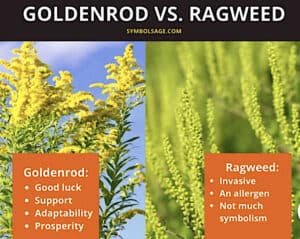 E ON WALT! Hope new version of the current Disney “Snow White” movie does NOT — as original did — slander our beautiful goldenrod! In original, Bashful shoves goldenrod into Sneezy’s face, hoping it triggers Sneezy’s terrible hay-fever. Truth: Goldenrod does NOT cause hay-fever! Ragweed, which likes to grow next to goldenrod, it the real culprit.
E ON WALT! Hope new version of the current Disney “Snow White” movie does NOT — as original did — slander our beautiful goldenrod! In original, Bashful shoves goldenrod into Sneezy’s face, hoping it triggers Sneezy’s terrible hay-fever. Truth: Goldenrod does NOT cause hay-fever! Ragweed, which likes to grow next to goldenrod, it the real culprit.
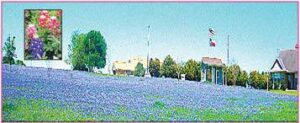 DON’T GET TOO HYPED if you see isolated early bluebonnets blooming now. All 6 varieties (!) of our State flower are Texas Tough! Massive bloom spreads will be along later.
DON’T GET TOO HYPED if you see isolated early bluebonnets blooming now. All 6 varieties (!) of our State flower are Texas Tough! Massive bloom spreads will be along later.
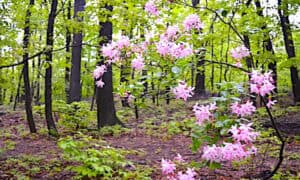 SPRING BRINGS wistful recall of trips to Wild Azalea Canyon outside Newton, once one of Texas’s largest concentration of these native treasures. The canyon was generously maintained free by Newton folks & other volunteers, who hand-striped “canes” for the less sure-footed!
SPRING BRINGS wistful recall of trips to Wild Azalea Canyon outside Newton, once one of Texas’s largest concentration of these native treasures. The canyon was generously maintained free by Newton folks & other volunteers, who hand-striped “canes” for the less sure-footed!
Human greed & weather traumas finally took toll. Our wonderful treasure lost forever. Despite monumental East Texas forest clear-cutting, they can occasionally can still be seen in East Texas but don’t do well in Houston. Gumbo soil’s too alkaline. They like sandy, slightly acidic soil. Sigh . . .
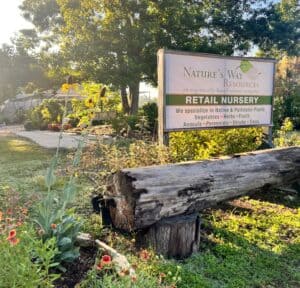 ATTN. GARDEN/PLANT GROUPS — In wake of Hurricane Beryl, Nature’s Way Resources offers free guided tours of NWR’s extensive nursery/soil/mulch facilities for garden clubs, plant societies and other plant-oriented, organized groups. As usual, NWR’s now-expanded meeting site is free to above groups. Reservations a must for both.
ATTN. GARDEN/PLANT GROUPS — In wake of Hurricane Beryl, Nature’s Way Resources offers free guided tours of NWR’s extensive nursery/soil/mulch facilities for garden clubs, plant societies and other plant-oriented, organized groups. As usual, NWR’s now-expanded meeting site is free to above groups. Reservations a must for both.
I actually knew someone who waited every spring to put in her new spring garden until Pantone announced its “Color of the Year.” Not sure how she’d have done it this year. Don’t find many ‘brown” blooms around these days!
Brenda Beust Smith’s column is based on her 40+ years as the Houston Chronicle’s “Lazy Gardener” column — lazygardenerbrenda@gmail.com Brenda’s column focuses ONLY on the Greater Houston Area
John’s Corner
NEWS FROM THE WONDERFUL WORLD
OF SOIL AND PLANTS
Subject: Pollen pests Organic Rising video fructose and cancer glyphosate drought & organic matter
A study published in the Journal of the Royal Society found that when butterflies and moths fly, they accumulate a static electrical charge. This electrical charge attracts pollen grains to the insect’s bodies across the air gap from as far away as a centimeter (a little less than ½ inch). The researchers studied 11 different species of butterflies and moth’s native to five different continents.
Has anyone noticed insect pests getting worse? An analysis of 120 papers found that air pollution affects beneficial insects more than pests. They reviewed 40 different types of insects in 19 different countries and how they respond to air pollution (ozone, nitrogen oxides, sulfur dioxide, and particulate matter).
They learned that pollinators (bees, moths and butterflies) had a drop in their foraging ability of 39% when exposed to air pollution. By comparison plant eating aphids and other pests were not impacted.
The researchers speculate that all insects (bees, wasps, etc.) who use scent-based communication are more affected as air pollution interrupts the scent trails they use.
There is a new documentary on organic farming that illustrates there is no need for the toxic chemical methodologies currently in use. It highlights the disastrous effects on the environment and human health from all the synthetic chemicals including herbicides and pesticides.
“Organic Rising is the first feature-length film to demystify organic agriculture for the consumer. Initially, the documentary presents the two predominant U.S. agrarian practices: conventional and organic, and how they impact human health and the planet. It simultaneously demystifies the USDA organic regulatory process and farming methods allowing consumers to make informed choices and explore avenues of supporting and maintaining a strong and robust agricultural future”. Acres, USA
Organic Rising is a solutions-focused documentary that helps consumers navigate America’s current foodscape and make decisions based on understanding rather than default acceptance of the status quo. ~ National Geographic
Note: There is a small fee for viewing the film to help cover their costs. Invite your friends and neighbors and have a watch party.
https://www.organicrisingfilm.com/the-film/
A study by Washington University in St. Louis found that the dietary sweetener fructose promotes tumor growth in animal models of melanoma, breast cancer, and cervical cancer. The researchers found that the liver converts fructose into useable nutrients for cancer cells thus helping them grow. Journal Nature (2024)
A study by Arizona State University and the Translational Genomics Research Center found that even at low doses glyphosate causes significant harm in animal studies. They found that a by product accumulated in brain tissue and was associated with premature death, anxiety-like behavior that persistent long after exposure. Journal of Neuroinflammation (2024)
This study follows previous ones that found exposure to glyphosate increased one’s risk of neurodegenerative disorders. Glyphosate is also a known carcinogen.
Another reason to purchase or grow organic foods. Since conventionally grown wheat, oats, soy, and other grains that are used in products from bread to cereals are sprayed with glyphosate to help them dry evenly to make harvesting easier.
Over the last few years many areas of Texas have been dealing with severe drought. One of the best ways to make one’s yard and garden more drought tolerant is to increase the organic matter of one’s soil.
Soil with 2 percent organic matter will absorb one inch of rain per hour while soil with 4.5 percent organic matter will absorb 5 inches of rain per hour. This implies that each additional one percent of soil organic matter will absorb 1.6 inches of rain per hour.
For reference, the prairies of the great plains had over 8% organic matter before they were plowed up. However, as gardeners we do not work with percentages hence a soil with 8% organic matter by weight is roughly equivalent to 25% by volume.
The two best ways to increase your soil organic matter is to incorporate a good compost into one’s garden or lawn and mulch with a good aged (partially composted) native mulch. They both provide nutrients for the microbes and plants and provide trillions of beneficial microbes.
A good aged native mulch due to its nutrients and high density of microbes will attract earthworms. Earthworms will carry the organic matter deep into the soil spreading it around without harming a plants root system by digging or tilling.
The nutrients and microbes in the native mulch feed the earthworms and they become very large and more numerous. The larger earthworm tunnels let the soil receive increased airflow and water to soak into the soil. The earthworms leave behind plant growth hormones called auxins in both their casting and they line their tunnels with it which in turn helps plans grow faster and healthier.
As an added benefit, when the earthworms pull organic matter into their tunnels or digestive track, if there are weed seeds present, they are destroyed, reducing this problem also. We know that mycorrhizal fungi are extremely important for plant growth and health. Earthworms also help spread the spores of this good fungi all through the soil as they tunnel.
Microbes found in a good aged native mulch, over time, will attack and break apart hard tight clay turning it into beautiful loam and releasing the nutrients.
SPONSORSHIP
If you are interested in becoming a sponsor, please contact us at 936-273-1200 or send an e-mail to: lazygardenerandfriends@gmail.com
ABOUT US
BRENDA BEUST SMITH WE KNOW HER BEST AS THE LAZY GARDENER . . .
- but Brenda Beust Smith is also:
- a national award-winning writer & editor
- a nationally-published writer & photographer
- a national horticultural speaker
- a former Houston Chronicle reporter
When the Chronicle discontinued Brenda’s 45-year-old Lazy Gardener” print column — started in the early ’70s as a fun side-project to reporting, it then ranked as the longestrunning, continuously-published local newspaper column in the Greater Houston area. The name, she says, is not just fun, it’s true.
Brenda’s gradual sideways step from reporter into gardening writing led first to an 18-year series of when-to-do-what Lazy Gardener Calendars, then to her Lazy Gardener’s Guide book which morphed into her Lazy Gardener’s Guide on CD, which she now emails free upon request.
Brenda became a Harris County Master Gardener and, over the years, served on theboards of many Greater Houston area horticulture organizations. She hosted local radio and TV shows, most notably a 10+-year Lazy Gardener specialty shows on HoustonPBS (Ch. 8) and her call-in “EcoGardening” show on KPFT-FM.
For over three decades, Brenda served as Assistant Production Manager of the GARDEN CLUB OF AMERICA’S “BULLETIN” magazine. Although still an active broad-based freelance writer, Brenda’s main focus now is THE LAZY GARDENER & FRIENDS HOUSTON GARDEN NEWSLETTER with John Ferguson and Pablo Hernandez of Nature’s Way Resources.
A native of New Orleans and graduate of St. Agnes Academy and the University of Houston, Brenda lives in Humble, TX, and is married to the retired Aldine High School Coach Bill Smith. They have one son, Blake.
Regarding this newsletter, Brenda is the lead writer, originator of it and the daily inspiration for it. We so appreciate the way she has made gardening such a fun way to celebrate life together for such a long time.
About her column, Brenda says: “I don’t consider myself a ‘garden writer.” I started out 50+ years ago as a very lazy “gardening reporter.” I still feel that way today. I hope my columns inspire/help newcomers, but I do not write to them. I write to very experienced gardeners who want to expand their horizons.
JOHN FERGUSON
John is a native Houstonian and has over 35 years of business experience. He owns Nature’s Way Resources, a composting company that specializes in high quality compost, mulch, and soil mixes. He holds a MS degree in Physics and Geology and is a licensed Soil Scientist in Texas.
John has won many awards in horticulture and environmental issues. For years he represented the composting industry on the Houston-Galveston Area Council for solid waste. His personal garden has been featured in several horticultural books and “Better Homes and Gardens” magazine. His business has been recognized in the Wall Street Journal for the quality and value of their products. He is a member of the Physics Honor Society and many other professional societies. John is the co-author of the book Organic Management for the Professional.
For this newsletter, John contributes articles regularly and is responsible for publishing it.
PABLO HERNANDEZ Pablo Hernandez is the special projects coordinator for Nature’s Way Resources. His realm of responsibilities include: serving as a webmaster, IT support, technical problem solving/troubleshooting, metrics management and quality control. Pablo helps this newsletter happen from a technical support standpoint.
Download the Newsletter with Our Events Calendar Below!
